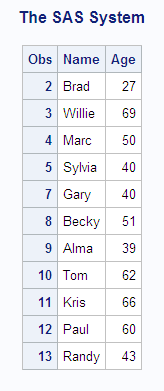OBS= Data Set Option
Specifies the last observation that SAS processes in a data set.
| Valid in: | DATA step and PROC steps |
| Category: | Observation Control |
| Default: | MAX |
| Restrictions: | Use with input data sets only. |
| Cannot use with PROC SQL views |
Syntax
Syntax Description
n | nK | nM | nG | nT
specifies a number
to indicate when to stop processing observations, with n as
an integer. Using one of the letter notations results in multiplying
the integer by a specific value. That is, specifying K (kilo) multiplies
the integer by 1,024; M (mega) multiplies by 1,048,576; G (giga)
multiplies by 1,073,741,824; or T (tera) multiplies by 1,099,511,627,776.
For example, a value of 20 specifies
20 observations, and a value of 3m specifies
3,145,728 observations.
hexX
specifies a number
to indicate when to stop processing as a hexadecimal value. You must
specify the value beginning with a number (0–9), followed by
an X. For example, the hexadecimal value F8 must
be specified as 0F8x in order to specify
the decimal equivalent of 248. The value 2dx specifies
the decimal equivalent of 45.
MIN
specifies the number to indicate when to stop processing to 0. Use OBS=0 to create an empty data set that has the structure, but not the observations, of another data set.
| Interaction | If OBS=0 and the NOREPLACE option is in effect, SAS can still take certain actions. SAS actually executes each DATA and PROC step in the program, using no observations. For example, SAS executes procedures, such as CONTENTS and DATASETS, that process libraries or SAS data sets. |
MAX
specifies the number to indicate when to stop processing to the maximum number of observations in the data set. This number can be up to the largest 8-byte, signed integer, which is 263–1, or approximately 9.2 quintillion. This is the default.
Details
(obs - firstobs) + 1 = results
(10 - 1) + 1 = 10.
If OBS=10 and FIRSTOBS=2, the result is nine observations. That is, (10
- 2) + 1 = 9. OBS= is valid only when an existing
SAS data set is read.
Comparisons
-
When the OBS= data set option specifies an ending point for processing, the FIRSTOBS= data set option specifies a starting point. The two options are often used together to define a range of observations to be processed.
-
The OBS= data set option enables you to select observations from SAS data sets. You can select observations to be read from external data files by using the OBS= option in the INFILE statement.
Examples
Example 1: Using OBS= to Specify When to Stop Processing Observations
(12
- 2) + 1 = 11. The result of OBS= appears to be the
observation number that SAS processes last.
data Ages; input Name $ Age; datalines; Miguel 53 Brad 27 Willie 69 Marc 50 Sylvia 40 Arun 25 Gary 40 Becky 51 Alma 39 Tom 62 Kris 66 Paul 60 Randy 43 Barbara 52 Virginia 72 ; proc print data=Ages (firstobs=2 obs=12); run;
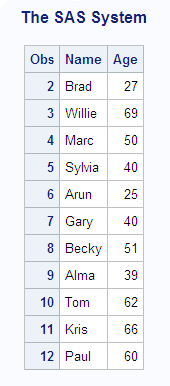
Example 2: PROC PRINT Using a WHERE Statement
proc print data=Ages; where Age LT 65; run;
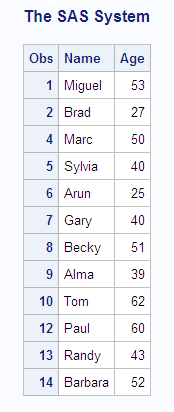
Example 3: PROC PRINT Using a WHERE Statement and OBS=
(10 - 1) + 1 = 10. With WHERE
processing, SAS subsets the data and applies OBS= to the subset.
proc print data=Ages (obs=10); where Age LT 65; run;
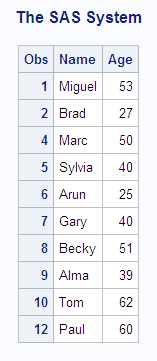
Example 4: PROC PRINT Using a WHERE Statement, OBS=, and FIRSTOBS=
(10 - 2) + 1 = 9. OBS= is neither
the observation number to end with nor how many observations to process;
the value is used in the formula to determine when to stop processing.
proc print data=Ages (firstobs=2 obs=10); where Age LT 65; run;
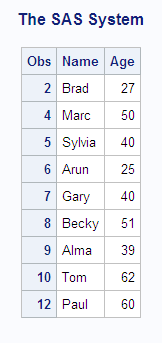
Example 5: PROC PRINT Showing Deleted Observations
proc print data=Ages; run;
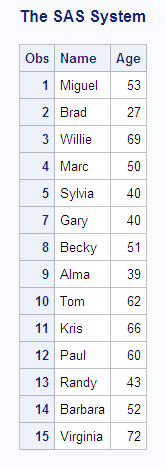
Example 6: PROC PRINT Using OBS=
(12
- 1) + 1 = 12: proc print data=Ages (obs=12); run;
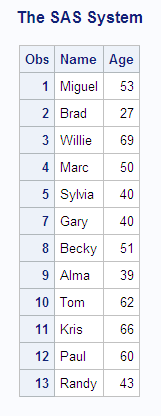
Example 7: Using OBS= When Observations Are Deleted
(12
- 2) + 1 = 11. OBS= is neither the observation number
to end with nor how many observations to process; the value is used
in the formula to determine when to stop processing.
proc print data=Ages (firstobs=2 obs=12); run;
